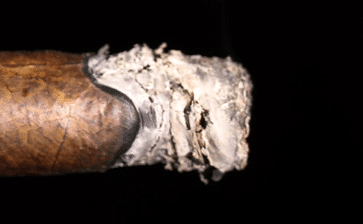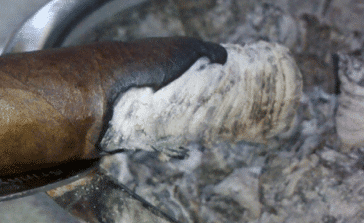During a smoke, it is possible to have combustion issues. Sometimes these problems are easily solved, but in some circumstances it is possible that somehow these problems affect the correct enjoyment of our beloved cigar. Hence the importance of a burn correction.
In regards to the problem of burn corrections, these manifest themselves with an imprecise and non homogeneous combustion of the external leaf, which results in an irregular burn line and the formation of unburned wrapper pieces. Normally the cigars that suffer most from this problem are the cigars that are characterized by a wrapper full of essential oils, very thick and of a Maduro color. Obviously the construction of the cigar and the skill of the roller are equally important from this point of view, as is the conservation. The excessive humidity can, in addition to creating draw issues, cause an imprecise and wavy burn line and therefore make numerous corrections necessary.
 |
 |
It is important that the smoke continues in a linear manner and for this it is necessary to act by correcting the burn line. To do this, the flame of the lighter must be brought close to the unburned portion of the wrapper (just for a few moments) and then „touch up” the burn. It is advisable not to overdo it. In many circumstances the problems highlighted resolve themselves within a few puffs, and therefore it would be useless to intervene to eliminate the natural balance of the combustion. What is certain is that if the part of unburned wrapper begins to be significant (say at least 3-4 mm), then, in this case, it is necessary to correct it quickly. The lack of intervention can lead the cigar to not express itself in the right way, the internal leaves (not only the wrapper) can start to burn in an uneven and irregular way, promoting a progressively less copious smoke and portions of unburned tobacco.
But is the need to touch up the burn line really to be considered a significant defect? The need to correct the burn is certainly not one of the worst problems. What is different is the possibility that the burn line hardly stays at the right temperature: in this case the smoke is heavily conditioned and the use of the flame to touch up the burn line (also with the jet flame) is absolutely essential to maintain straight burn. As far as accidental „going out“ is concerned, it can be said that this is one of the least appreciated inconveniences for the vast majority of smokers. This problem can be due to three different reasons:
- Bad construction
- Excessive humidity of the cigar
- Carelessness during the smoke
The bad construction of the cigar is obviously attributable to manufacturing. As you know, it is the Volado leaf (present in the filler of the cigar, but sometimes also used as a binder) that is used specifically for the regular combustion of the cigar. The imperfect positioning and the insufficient quantity of this type of leaf – as well as a poor roll – can lead (but not only) to sudden and discouraging extinctions.
In the second case, instead, the conservation parameters with an adequate relative humidity (RH) have not been respected and the hygroscopic capacity of the tobacco (able to absorb and lose water) leads the cigar to not have the right combustion mechanism and subsequently go out. This can happen especially with fresh cigars (remember that in Cuba the tobacco is rolled „wetter“ than in other Caribbean producing countries), but obviously this can be re-proposed also with reference to the conservation by the final consumer.
But if the construction and conservation of the cigar are optimal, there is a last hypothesis to be evaluated in the case of the occurrence of accidental extinguishing: the smoker’s carelessness. The cigar should never be left alone for too long, it will respond by asking for the right attention and correct cadence of the puffs. And obviously it will manifest these needs by suddenly ceasing to do his duty.
But what should you do when the cigar goes out? The first thing is to shake the ash off as accurately as possible, perhaps using some tools to completely clean the burn from the ash. It is possible to proceed with the immediate re-light, first heating the outer part and then passing on to light the center of the cigar, by then bringing it to the mouth to perform 2-3 fast and rhythmic puffs. The cigar will then resume its normal cruising speed. In the event that you do not want to proceed immediately with the re-light, but if you want, or have to wait a few minutes for example, we suggest adding the “limpar” technique to the procedure described above, which consists in blowing lightly into the cigar to let out the stale smoke before relighting it. This operation serves to prevent the smoke left in the cigar from passing from the gaseous to the liquid state (due to the lowering of the temperature) causing the deposit of “unpleasant” substances on the tobacco. In the re-light phase, these residues would lead to the occurrence of a handful of absolutely unpleasant bitter puffs
Therefore, pay attention to what happens to your cigar: observe it with a certain frequency and intervene only if strictly necessary. But when it is appropriate to do so, act resolutely to bring the situation back to normal. The smoke will certainly benefit and eventually the small / large combustion problems can be resolved without excessively ruining the quality of your relaxation.

